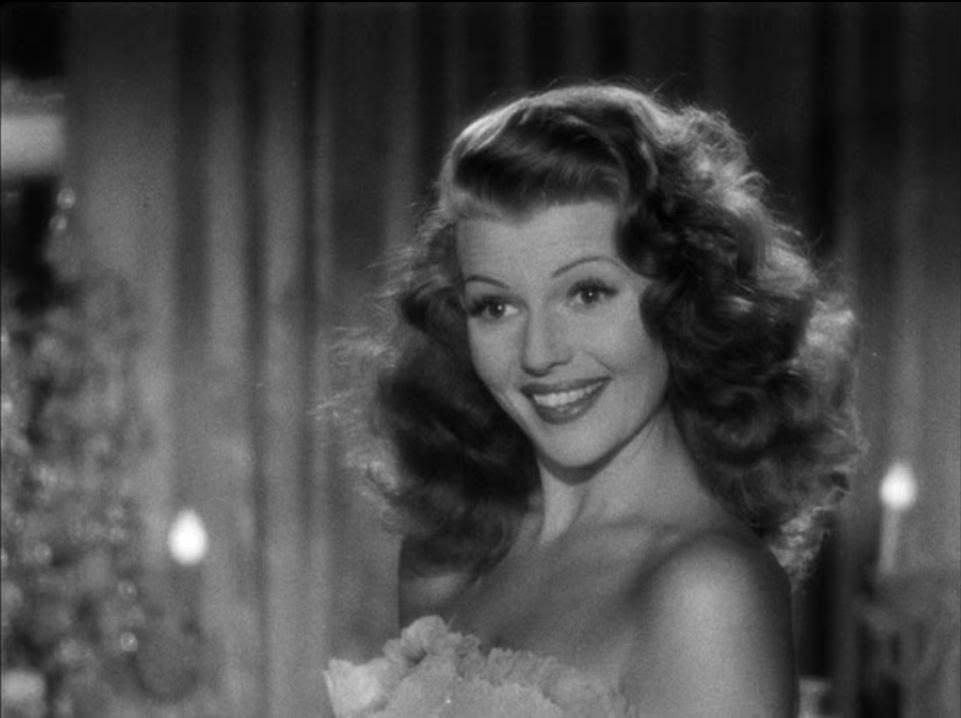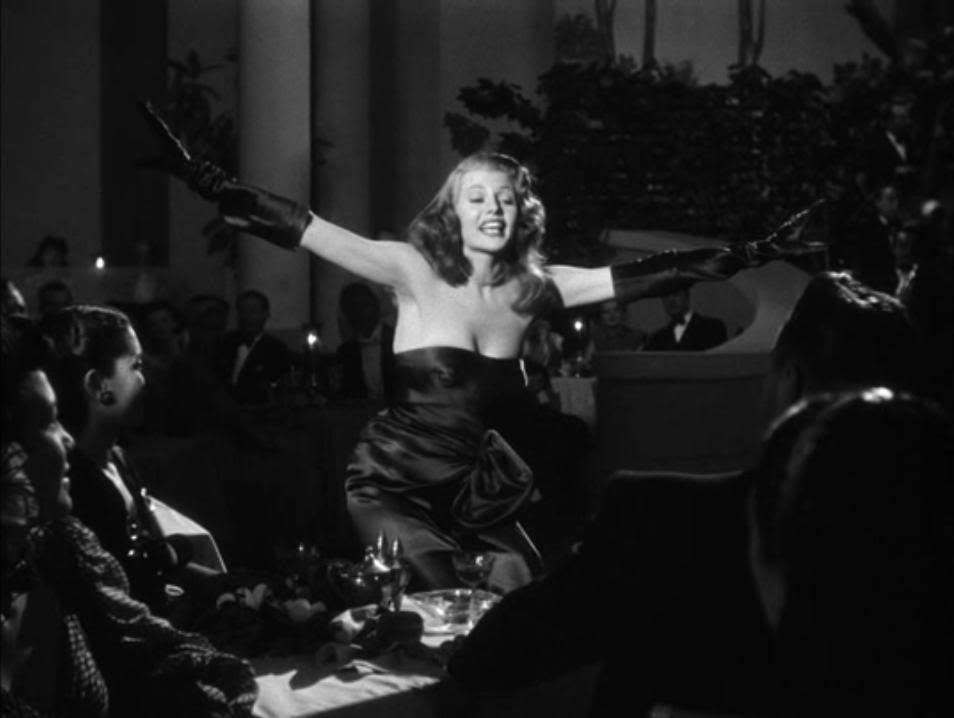
The thing that makes Gilda such a classic as a noirish love story is the way in which it boldly mingles love and hate, to the point where the two emotions, in their strongest and most virulent forms, become virtually indistinguishable from one another. This point is made again and again in the script, in the most literal terms, as all of the characters speak of how close strong love and strong hate are to one another, how easily one could be mixed up with the other, and how at times it can seem like the intensity of an emotion can be more important than the specific emotion that's being felt. The script is built around this idea, but, as befits such an emotionally charged concept, it's expressed most powerfully not in words but in the love/hate, push/pull sexual tension that develops in the midst of the film's central love triangle.
This is a film with some interesting things to say about triangles, for sure. The first triangle in the film develops, not between two men and a woman, but between two men and a weapon: the rich, corrupt casino owner Ballin Mundson (George Macready), the down-on-his-luck crooked gambler Johnny Farrell (Glenn Ford) and Mundson's cane, which hides a blade that he refers to, rather phallically, as his "little friend." Soon enough, Mundson pulls Johnny into his business and begins to refer to him, too, as a little friend, someone he can rely upon to help with his business, someone who's as trustworthy as his weapon. That threesome will change when Mundson marries Gilda (Rita Hayworth), who unbeknown to Mundson already has a history with Johnny, his trusty little friend. Neither Johnny nor Gilda is very happy with this state of affairs, especially Johnny, who's upset that his original, homoerotic triangle with Mundson has been broken apart by a woman — and as Mundson himself says before meeting Gilda, women are nothing but trouble for gamblers.
When Mundson introduces Johnny to Gilda, there's a weird tension between the three of them almost instantly. Mundson is swelling with pride, eager to show off his beautiful bride, but Johnny is jealous before he even sees the woman, as though he's jealous not of Mundson for scoring a beautiful woman, but jealous of her for taking away his friend and benefactor. Then Gilda appears, bursting into the frame, standing up into a ravishing, thrilling closeup, whipping her hair back, her dress hanging off her bare shoulders, a mischievous smile on her face as her husband asks if she's decent. Her lips curve up in that glorious smile, a little glint flashes in her eyes and she seems on the verge of answering him with a predictable wisecrack — "Me? Never," one imagines her saying, holding that same naughty smile all the while — but instead the smile fades a little when she sees Johnny, and she forgoes the banter to say that she is decent, as though already constructing her defense against Johnny's as-yet-unspoken accusations. The introduction is fraught with these tensions, as the dialogue crackles and sparks with barely submerged antagonism, particularly when she implies that she views Johnny as just some more of the "hired help," slighting him as forgettable and insignificant, even though something in her tone, nasty as it is, suggests that exactly the opposite is the case.

Hayworth plays Gilda, not as a tramp, but as a woman who's been told she's a tramp so often that she's started to believe it, that she's decided to live up — or down — to the reputation. She shamelessly admits that she married Mundson for his money — more than that, that she allowed herself to be bought, which makes it sound even more like prostitution, like a transaction. And once she's married she begins running around with other men almost immediately, more to make Johnny jealous than to have any effect on her husband, who seems to mean very little indeed to her. Over the course of the film, Hayworth betrays more and more of the insecurity and desperation lurking beneath her seemingly cavalier exterior — she's playing at being a femme fatale, but in fact she's been deeply wounded, and now she's trying her hand at wounding the man who hurt her so badly. Behind each of her smiles, each of her barely disguised insults and subtle slights, lurks a reservoir of hatred and anguish, a desire and a love so strong that it's curdled into contempt, and a correspondingly tangled self-image.
The film coasts by on the power of Hayworth's performance, on the complicated emotions that she projects from within her outwardly vivacious form, and on the quick wit of the verbose screenplay. The dialogue has real pop to it, real bite. It's a writer's picture, not a director's — Charles Vidor's direction is glossy but unexceptional — and it's no surprise to see that writer Ben Hecht was an uncredited contributor to this punchy script. These characters are constantly using words to hurt one another, slicing at each other with pointed jokes and barbed comments. Johnny even makes the comparison to weapons explicit when he says that Mundson's cane/blade — which Gilda is replacing as the third point of this bizarre triangle — must be feminine rather than masculine, because "it looks like one thing but right before your eyes it becomes another." Johnny's hatred of women, and especially of Gilda as a representative of women, is even more potently expressed in his nasty joke: "there are more women in the world than anything else... except insects." Gilda is more direct, expressing her hatred in especially naked terms, saying, "I hate you so much that I would destroy myself to take you down with me." Love, transmuting into hate, doesn't get any more intense than that.
That's the core of the film, and it's embodied almost exclusively in Hayworth. Ford and Macready, as the other points of this triangle, glower and mope but seem pint-sized, insignificant, in comparison to the bold, exuberant womanhood of Hayworth's Gilda, who seems to feel so much, so intensely and generously, that she dwarfs the men with the magnitude of both her smiles and her tears. Hayworth even transforms a seemingly joyful song-and-dance striptease number — her hip-shaking, devastatingly sexy performance of "Blame It On Mame" — into an expression of her inner turmoil. To the appreciative crowd, she looks like she's having a ball, gleefully stripping off her black gloves and throwing them into the audience, bending over to allow her cleavage to spill out of a ludicrously low-cut dress, even tossing away the necklace from around her neck, and finally, naughtily, inviting some guys to come up on stage and unzip her dress, keeping a big grin on her face the whole time. In fact, she's doing it only to hurt Johnny, to cut into him by trying to live up, again, to his impression of her as a cheap tramp. She's rubbing it — her willingness to embody the woman he hates — in his face.
There's a plot in here somewhere, one that has nothing to do with the central love triangle, and which is therefore just a distraction from what really matters in this film. All the weird business about tungsten monopolies and shady international conglomerates just fades into the background in comparison to the sheer intensity of the tragic romance. The film's ending gets a little too tied up in those cops-and-criminals machinations, and turns more than a little too corny in its tidy resolution, but before that point it's a poignant, sexually charged examination of love and hate.
"This is a film with some interesting things to say about triangles, for sure. The first triangle in the film develops, not between two men and a woman, but between two men and a weapon: the rich, corrupt casino owner Ballin Mundson (George Macready), the down-on-his-luck crooked gambler Johnny Farrell (Glenn Ford) and Mundson's cane, which hides a blade that he refers to, rather phallically, as his "little friend."
ReplyDeleteGILDA is of course Vidor’s one great film, and I’m inclined to believe the homoerotic context was wholly intended. But Rita Hayworth is front and center, and the ordinary plot is pushed to the background as the ferociously charged performance by her is a cinematic milestone. Her barbaric dance in the nightclub, peeling off her long black gloves, was every GI’s dream. Of course there was an erotic strain throughout and Rudolph Mate’s glistening photography is wholly extraordinary. Repressed sexuality, compromised loyalties and sadomasochism are all part of this potent American classic, a film which rewards repeat viewings with added psychological insights.
Yet again, another examination of film noir at ONLY THE CINEMA that sets the bar.
Sam, I agree that the homoeroticism is intentional. There's really no other way to read some of these scenes, especially all the jokes about the "little friend." "Repressed sexuality, compromised loyalties and sadomasochism" - definitely the heart of a film with some very complex subtexts and some very raw sexuality for a Hollywood classic.
ReplyDeleteThe homoeroticism -- set alongside a heterosexual spectator's obvious desire for the overwhelmingly luscious Rita Hayworth -- makes Glida both truly bizarre and teelingly true. The key line is "Then the war eneded." The film is all about residual erotic tension (both hetero and homo) left in its wake. Gilda's taunting sexuality speaks to a soldier's nightmare that "the girl he left behind" was carrying on with all and sundry. At the same time, Munson is a swellegant version of the men said solder was enjoying "on the down low" (as we say these days) during the war. James Jones' novel "From Here To Eternity" deals with this simple "shocking" fact in much detail. The "cleaned-up" movie and made-for-TV versions omits it completely.
ReplyDeleteJack Cole directed Rita's on-glove striptease in the "Put the Blame On Mame" number. While his work as a full-press choreographer is mind-boggling (eg. Kismet) Cole did a lot of "special handling" with stars like Hayworth and Marilyn Monroe as well. Marilyn couldn't remember her lines, but when Cole taught all her moves to her as a piece of choeography she "got it" completely.
"Hayworth plays Gilda, not as a tramp, but as a woman who's been told she's a tramp so often that she's started to believe it, that she's decided to live up — or down — to the reputation." Well said Ed!
ReplyDeleteGilda unquestionably remains a famous film noir. However for me it wouldn't rank as iconic or archetypal as a number of other film noirs like say The Killers, The Big Combo, etc. In darkness quotient too it wouldn't rank very high.
Nonetheless, having said that, the movie did manage to produce a striking interplay of, as you mentioned, love and hate. Rita Hayworth did a fabulous job as the enigmatic Gilda through her acting prowess as well as her natural charm.
David, I hadn't thought about this as an explicitly postwar film, but of course that interpretation makes a lot of sense, as the male bonding/homoeroticism is brought into conflict with the heterosexual relationship.
ReplyDeleteShubhajit, I probably wouldn't rank it *quite* in the top ranks of noir either, but it's a great film anyway, with Hayworth's unforgettable presence and the dark, twisty themes and subtexts of the story.
Speaking of movie goddesses, Latest FaBlog: Doris Mary Kappelhoff is 88
ReplyDelete